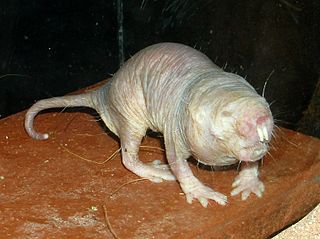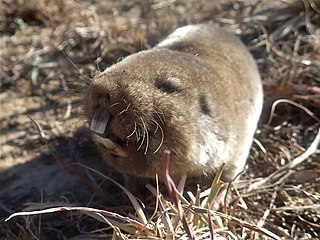
The naked mole-rat, also known as the sand puppy, is a burrowing rodent native to the Horn of Africa and parts of Kenya, notably in Somali regions. It is closely related to the blesmols and is the only species in the genus Heterocephalus.

The Spalacidae, or spalacids, are a family of rodents in the large and complex superfamily Muroidea. They are native to eastern Asia, the Horn of Africa, the Middle East, and southeastern Europe. It includes the blind mole-rats, bamboo rats, mole-rats, and zokors. This family represents the oldest split in the muroid superfamily, and comprises animals adapted to a subterranean way of life. These rodents were thought to have evolved adaptations to living underground independently until recent genetic studies demonstrated they form a monophyletic group. Members of the Spalacidae are often placed in the family Muridae along with all other members of the Muroidea.

The blesmols, also known as mole-rats, or African mole-rats, are burrowing rodents of the family Bathyergidae. They represent a distinct evolution of a subterranean life among rodents much like the pocket gophers of North America, the tuco-tucos in South America, and the Spalacidae from Eurasia.

The Damaraland mole-rat, Damara mole rat or Damaraland blesmol, is a burrowing rodent found in southern Africa. Along with the smaller, less hairy, naked mole rat, it is a species of eusocial mammal.

Cryptomys is the genus of mole-rats, endemic to Africa. Most of the species formerly placed in this genus were moved to the genus Fukomys in 2006.

Ansell's mole-rat is a species of rodent in the family Bathyergidae. It is endemic to Zambia. Its natural habitats are moist savanna and miombo forests. It is noted for its very long tunnels, up to 2.8 km (1.7 mi) for a single colony of only ten individuals. The colonies are made of a eusocial system. They include a main reproductive king and queen that are thought to be faithful to one another.
Bocage's mole-rat is a species of rodent in the family Bathyergidae. It is found in Angola, Namibia, possibly Democratic Republic of the Congo, and possibly Zambia. Its natural habitats are subtropical or tropical dry forests, dry savanna, subtropical or tropical dry lowland grassland, and caves.

The Mashona mole-rat is a species of rodent in the family Bathyergidae. It is found in Mozambique and Zimbabwe. Its natural habitats are subtropical or tropical dry shrubland, subtropical or tropical dry lowland grassland, and caves.
The Nigerian mole-rat is a species of rodent in the family Bathyergidae. It is found in northern Nigeria and Cameroon. A colonial, subterranean species, its natural habitats are tropical dry lowland grassland, riverside woodland and rocky places.
The Kafue mole-rat is a species of rodent in the family Bathyergidae. It is endemic to Zambia. Its natural habitat is moist savanna.

Mechow's mole-rat is a species of rodent in the family Bathyergidae. It is found in Angola, Democratic Republic of the Congo, Zambia, and possibly Malawi. Its natural habitats are moist savanna, subtropical or tropical dry shrubland, and subtropical or tropical dry lowland grassland. This mole-rat was first described by the German naturalist Wilhelm Peters in 1881. The specific epithet honours the Prussian explorer and naturalist Friedrich Wilhelm Alexander von Mechow.
The ochre mole-rat is a species of rodent in the family Bathyergidae. It is found in Central African Republic, Democratic Republic of the Congo, South Sudan, and Uganda. Its natural habitats are moist savanna, subtropical or tropical dry shrubland, subtropical or tropical dry lowland grassland, caves, and arable land.
The Ghana mole-rat or Togo mole-rat is a species of rodent in the family Bathyergidae. It is endemic to Ghana.

The northeast African mole-rat is a species of rodent in the family Spalacidae and is found in Ethiopia, Somalia, and northwest Kenya. Its natural habitats are subtropical or tropical moist montane forests, dry savanna, high-altitude shrubland and grassland. It lives a solitary existence underground and produces a small litter of pups twice a year, in the two rainy seasons. Some taxonomic authorities lump this species, along with a number of others in the genus, in which case the English name East African mole-rat is used.
The Zambian mole-rat is a species of rodent in the family Bathyergidae. It is found in Zambia and the Democratic Republic of the Congo. It was formerly considered a subspecies of Cryptomys hottentotus.

Fukomys is a genus described in 2006 of common mole-rats, containing several species that were formerly placed in the genus Cryptomys; its species are endemic to Africa. The species contained in the genus includes :
Fukomys vandewoestijneae or Caroline's mole rat was first noticed in 2002 by a research team from the University of Ghent. This new species, distinguished by a distinctive skull shape, was recently described by Paul Van Daele and his team in Zootaxa while DNA and chromosome tests confirmed its novelty. The new species was named after Van Daele's late wife, Caroline Van De Woestijne, who was a member of the research team and died of malaria while in Africa.
The Micklem's mole-rat is a species of rodent in the family Bathyergidae. It is found in Zambia. It is a subterranean species of chisel tooth diggers.
Fukomys livingstoni is a species of mole rat that can be found in Africa.
The Hanang mole-rat is a species of mole rat. It was discovered in 2017 in Tanzania.








